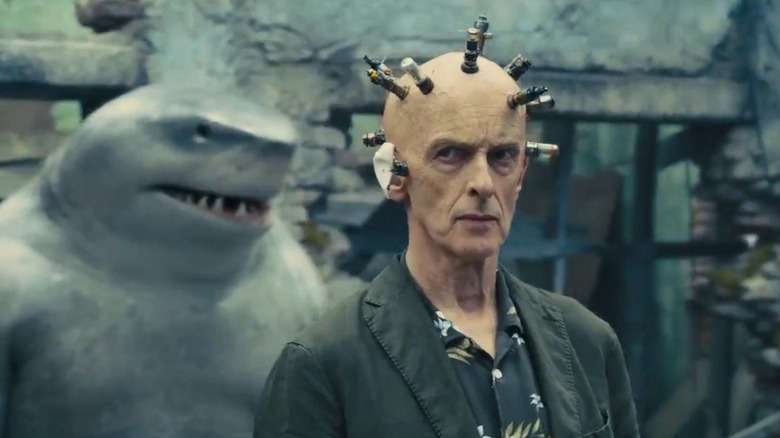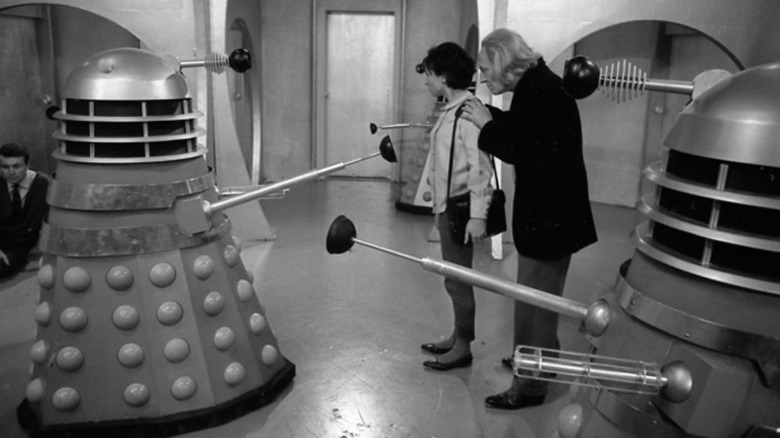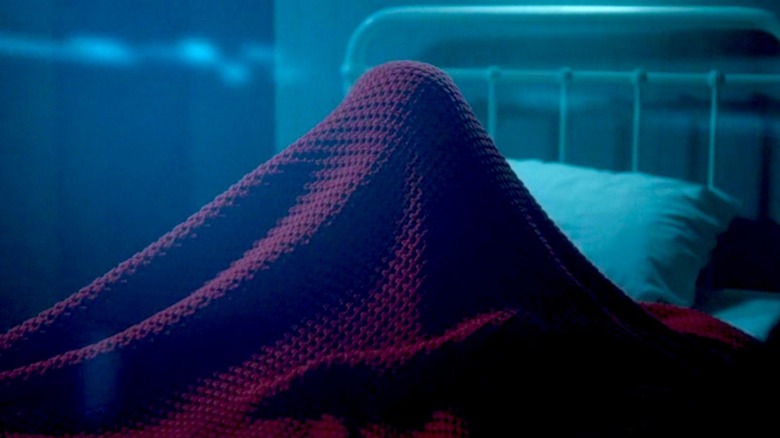Peter Capaldi Had Some Harsh Words About Doctor Who's Prop Quality
The past decade has seen Peter Capaldi go from playing the hero of the beloved British family show "Doctor Who" to a sociopathic scientist known as the Thinker in "The Suicide Squad." A stark departure from the brave, optimistic Doctor, the Thinker's the type of guy the Doctor would be taking down in one of his weekly adventures. Although James Gunn's R-rated blockbuster was a major departure from "Doctor Who," from its over-the-top violence to its raunchy sense of humor, there was one main difference between the two that stuck out to Capaldi: "The Suicide Squad" had way, way more money behind it. Both projects may have dealt with aliens and world-ending stakes, but the non-human characters of "The Suicide Squad" looked a lot more believable than the aliens you'd see on "Doctor Who." In an interview with The Daily Mail, Capaldi explained why.
"With 'Doctor Who,' we don't really have enough — everything on 'Doctor Who' falls to pieces, all of the props fall to pieces and the costumes have to be stuck together with duct tape and velcro and stuff."
Whovians are well aware of this issue. Throughout most of the show's run (be it Classic Who or NuWho), the budget for props and special effects never exactly seemed impressive. From the Mara snake to the man-eating bins, "Doctor Who" has always asked its audience to rely on their imaginations more than they would for other shows.
Doctor Who has always looked a little cheap
Most Whovians can attest that the cheapness of the production is part of the show's charm. Up until 2010 and even occasionally afterward, the monsters on the screen are often clearly people in costumes, and we've learned to not just make peace with this, but to embrace it. Rewatching classic episodes, we're reminded every time the set wobbles that this isn't a show that takes itself too seriously, that its real strength is in the unique concepts it explores, not its shoestring budget. As Capaldi put it in that same interview:
"I like the kind of B movie kind of cobbled together, quality of it. That ... there's never really quite enough money, but the ideas are often very special."
But as the show's limited props and special effects budget are still clear to viewers even in its latest episodes, it's hard not to feel a little frustrated, especially as other TV shows have a lot more to work with. If "Game of Thrones" could have realistic large-scale battles on HBO as early as 2012, "Doctor Who" shouldn't still look so shabby in 2022. As previous showrunner Steven Moffat put it: "A show that generates as much money as 'Doctor Who' should be getting more of it back, frankly."
Unfortunately, "Doctor Who" is produced by the publicly-funded BBC, which has struggled in recent year's due to the U.K. government's unwillingness to raise the license fee to keep up with inflation. As a result, "Doctor Who" doesn't receive the budget you'd expect from a network's most popular show. With no end in sight to the BBC's financial troubles, it doesn't seem like the cheap feel of the show will go away any time soon.
The creative ways they saved money
Even as the show lags behind its competition, the aliens of "Doctor Who" do certainly look better than they used to. As much as fans argue over the whether or not the writing in Russell T. Davies' era of the show (2005-2009) was better than Steven Moffat's era (2010-2017), the special effects of the latter are undeniably improved, and the CGI jumped in quality again as Chris Chibnall took over as showrunner. It's funny to watch the "Impossible Astronaut" two-parter in season 6 and remember that this is the same show that gave us the Adipose just a few years earlier.
But as Capaldi mentioned, it's the ideas that really make the show shine. It's not a coincidence that some of the show's best episodes ever are the ones where the monsters don't need any CGI to be particularly effective. Season 3's "Blink" is still the show's most highly-regarded episode, and due to the creative nature of its alien villains (they're statues that only move when we can't see them), the spooky atmosphere was never undermined by cheap-looking effects. Episodes like "Midnight" or "Silence in the Library," where the monster is never fully seen, also rank among the show's best.
One of the most effective horror sequences in the show is the moment in season 8's "Listen" where the Doctor and Clara (Jenna Coleman) come across a mysterious figure hiding under a blanket. The person under the blanket could just be a kid pulling a prank, but everything about the way the Doctor reacts makes us think it's something much worse. The prop budget for this scene was remarkably cheap (all they needed was a blanket) but it's one of the most suspenseful and unnerving moments in the entire show.
"Doctor Who" has always been one of the most creative shows on TV, not always despite its low budget, but because of it. The show has often embraced the idea that the viewer's imagination can be more terrifying than the scariest monster they can put on screen. It's easy to be cynical and say that the show's refusal to reveal what the Weeping Angels in "Blink" look like as they move is nothing more than a blatant attempt to save money, but it's that very choice that made the Weeping Angels so terrifying to begin with. Even if "Doctor Who" never gets the budget it deserves, we at least know the writers are creative enough to keep throwing in some genuine scares.


